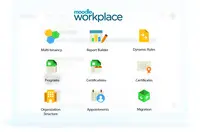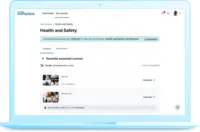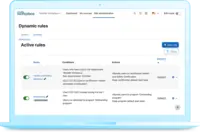Overview
What is Moodle?
Moodle is an open source learning management system with hundreds of millions of users around the globe and translated into over 100 languages, used by organizations to support their education and training needs.
A simple and useful online method for distant learning
Best LMS Solution
Moodle Workplace - Perfect workplace learning tool
Great LMS, Non-existent customer service
Moodle in a Mid-Sized Company - Great Value
Easy installation, cost effective solution for institutions with technically talented staff to implement.
Moodle for everyone
Are you a teacher looking for Learning Management System that is simple, functional, and easy to use? Moodle has it all for you!
Useful tool for online course content
Learning with Moodle
Moodle is a flexible and reliable learning management system that is great for assessment too.
Learning management at its best, considering the price point
Best tool for web based learning.
You get what you pay for
Moodle provides education across many industries and ages
Awards
Products that are considered exceptional by their customers based on a variety of criteria win TrustRadius awards. Learn more about the types of TrustRadius awards to make the best purchase decision. More about TrustRadius Awards
Popular Features
- Progress tracking & certifications (25)10.0100%
- Assignments (26)9.898%
- Learning administration (24)9.898%
- Course catalog or library (23)9.696%
Pricing
What is Moodle?
Moodle is an open source learning management system with hundreds of millions of users around the globe and translated into over 100 languages, used by organizations to support their education and training needs.
Entry-level set up fee?
- Setup fee optional
Offerings
- Free Trial
- Free/Freemium Version
- Premium Consulting/Integration Services
Would you like us to let the vendor know that you want pricing?
86 people also want pricing
Alternatives Pricing
What is ProProfs LMS Software?
ProProfs LMS is a learning management system software that is designed to help instructors create and deliver online training courses. The LMS offers both businesses and educational institutions comprehensive training solutions by allowing them to create online courses, complemented by tests,…
Product Demos
How to take Demo Assignment and appear in ESE-2020 by Moodle App from Mobile
MEDIAL Plugin for Moodle - Demo Video
Moodle Demo | Account Creation | Teacher View | Student View | Adding Resources | Joining Courses
Moodle Webex Integration Demo
French on an e-learning platform - Clip Class' Moodle
Moodle Google Hangout Demo
Features
Learning Management
Features of LMS and LCMS systems, related to designing, administering, and consuming learning content in an educational, corporate, or on-the-job context.
- 9.4Course authoring(22) Ratings
Users can develop and assemble online learning content.
- 9.6Course catalog or library(23) Ratings
Learning content is organized into a course catalog or browsable library.
- 9.2Player/Portal(23) Ratings
Students or employees can engage with content and take courses using this interface, which may be called a player or portal.
- 10Learning content(21) Ratings
The vendor offers high quality pre-made courses or assets. These may be specific to certain industries or technologies.
- 9.4Mobile friendly(23) Ratings
Students or employees can access content from mobile devices. Course authors can develop responsive learning content.
- 10Progress tracking & certifications(25) Ratings
The system tracks individuals’ progress on courses, scores, transcripts, certificates, etc.
- 9.8Assignments(26) Ratings
Users can assign courses/curricula to individuals or groups, with due dates.
- 9.2Compliance management(20) Ratings
Users can identify potential risks and ensure that requirements are met and that certifications are up to date.
- 9.8Learning administration(24) Ratings
Administrators can manage the content and people (students/employees, course authors, instructors, etc.) on the platform.
- 7.8Learning reporting & analytics(22) Ratings
Provides insights into course completion, engagement with learning content, etc.
- 9.4Social learning(23) Ratings
Includes features for collaboration and knowledge sharing among peers.
Product Details
- About
- Integrations
- Competitors
- Tech Details
- FAQs
What is Moodle?
Moodle Features
Learning Management Features
- Supported: Course authoring
- Supported: Course catalog or library
- Supported: Player/Portal
- Supported: Learning content
- Supported: Mobile friendly
- Supported: Progress tracking & certifications
- Supported: Assignments
- Supported: Compliance management
- Supported: Learning administration
- Supported: Learning reporting & analytics
- Supported: eLearning
- Supported: Assessments
- Supported: Live online learning
- Supported: In-person learning
- Supported: Micro-learning
- Supported: Video learning
- Supported: eCommerce
- Supported: AICC-compliant
- Supported: SCORM-compliant
- Supported: Tin Can (xAPI) compliant
- Supported: Social learning
- Supported: Gamification
- Supported: GDPR Compliant Learning
- Supported: Single Sign On (SSO) Enabled Learning
Moodle Screenshots
Moodle Videos
Moodle Integrations
Moodle Competitors
Moodle Technical Details
| Deployment Types | On-premise, Software as a Service (SaaS), Cloud, or Web-Based |
|---|---|
| Operating Systems | Windows, Linux, Mac |
| Mobile Application | Apple iOS, Android, Windows Phone, Blackberry, Mobile Web |
| Supported Countries | Worldwide |
| Supported Languages | All languages |
Frequently Asked Questions
Comparisons
Compare with
Reviews and Ratings
(244)Community Insights
- Business Problems Solved
- Pros
- Cons
- Recommendations
Moodle has a wide range of use cases across different educational institutions and organizations. In higher education, it facilitates communication, provides learning materials, and assesses student learning. It serves as an essential training portal, offering online courses, quick reference guides, and knowledge base articles. This platform also caters to organizations' learning and development needs, accommodating different skill sets and objectives. Additionally, it supports early intervention providers by enabling self-enrollment, progress tracking, assessment recording, and grade viewing. For instructors in both online and face-to-face classes, Moodle acts as a Course Management System for posting and grading assignments, exams, and quizzes. Librarians can participate in professional development remotely through Moodle's various media options and scoring reporting features. It is also used for safety training coursework with the flexibility to integrate different media types. In K-12 schools, Moodle supplements courses such as Health Education and offers online courses during summer months. Private liberal arts colleges rely on this platform for student engagement, activity tracking, and grading. Furthermore, Francis Lewis High School has found that Moodle increases enrichment for students while streamlining the workload for educators.
Moodle is recognized for its continual development, simplicity, and vibrant community support. This makes it a suitable choice for those new to e-learning as well as school districts with limited resources. It's designed to enhance teaching and learning experiences through features like lecture note uploads, progress monitoring, grading tools, online quizzes/tests, and reporting capabilities. Beyond the education sector, Moodle supports internal communication within companies by providing chat functionality and information sharing between managers and employees at all levels. Moreover, it serves as a useful tool for task management and constant updates on assignments to improve workflow efficiency. Whether it is hosting online courses for K-12 schools or managing faculty development opportunities across campuses or facilitating information sharing within committees or group projects—Moodle accommodates a wide range of needs. It tracks training delivery for state employees, delivers student orientation, manages various rotations, organizes coursework for faculty members, and provides a centralized space for sharing course-related information, assignments, grading, and document repository.
Flexibility for customization: Users appreciate the open-source nature of Moodle, as it allows for easy extension and customization without additional costs. This flexibility is highly valued by many reviewers, as it enables them to tailor the platform to their specific needs and avoid clutter.
Active user community: The active user community of Moodle is praised for its continuous support and extension of the platform. Many reviewers commend the engagement process and transparent roadmap for development, which gives users a clear understanding of the platform's future direction. They also value being able to contribute directly by fixing bugs or enhancing functionality.
Strong support for learner interaction: Users find that Moodle's constructivist design supports various means of learner interaction. Many reviewers specifically mention the strong support for discussions within Moodle, facilitating effective communication and collaboration among learners.
Outdated and Confusing User Interface: Several users have expressed dissatisfaction with the user interface of Moodle, finding it to be dated and confusing. They feel that it is difficult to navigate and locate specific features within the platform.
Limited Reporting Tools: Many reviewers have noted that the reporting tools in Moodle are not sufficient for their needs. They often have to rely on third-party plugins to generate comprehensive reports, which can be inconvenient and time-consuming.
Complex Gradebook Functionality: The gradebook function in Moodle has been a source of frustration for many users. They find it complex and overwhelming, with numerous options and settings that can be difficult to understand. This complexity leads to an increase in support questions and makes it challenging for beginners or intermediate users to effectively utilize the gradebook.
Based on user reviews, here are the three most common recommendations for Moodle:
-
Users highly recommend taking advantage of online resources and YouTube videos for assistance with setting up and managing Moodle. These external sources can provide valuable guidance and support throughout the process.
-
Users recommend Moodle for those looking to do virtual education or distance learning. Moodle is recommended due to its many features and status as an open-source resource.
-
Users recommend exploring the plugin library in Moodle to discover additional tools and ways to engage students. This feature offers a range of options for enhancing the learning experience and providing diverse learning opportunities.
Overall, these recommendations emphasize the importance of seeking external resources, exploring alternatives, and utilizing additional features to optimize the use of Moodle as a learning management system.
Attribute Ratings
Reviews
(1-5 of 5)Moodle at McNeese
- Moodle provides a vast variety of using technology in ways that the instructor or student with little experience with technology is able to use it. All of our instructors received beginning training in how to use Moodle before we switched over to it, so that they felt comfortable with the switch. They could come to the training more than one time if they chose to.
- I give all of our instructors more advanced training when they choose to teach the fully online courses, and they also receive training in additional software. They also receive a webcam and they can also receive a document camera if they are a math or an accounting instructor.
- They have also received Camtasia and Snagit which work well with Moodle. They may basically use any software and are able to upload their own videos, videos from the Internet, any sort of PowerPoints that they create with their own voice or video, extra technology, notes, etc. for the students.
- The instructors use a variety of modules within Moodle. We have available for their use BigBlueButton, which is a webinar. It provides guests appearances and provides office hours for our instructors who have strictly web based courses. They also have Turnitin, which is the plagiarism tool, Turning Tech that is the linked in tool that provides a quiz taking that links to Moodle and to the gradebook. We also use Tegrity that delivers the instructors and the students with an additional tool that permits them to do a video, or a PowerPoint or allow the instructor to link to anything on the computer and to upload it into Moodle. We also have the Attendance module, which allows the instructors who take attendance in the classroom to give the students "points" for attendance. We are adding the Ebsco reading list for the library this summer, which lets individual instructors to add certain reading lists from the library for their individual classrooms.
- Right now, our Moodle is not working with our Banner product in being able to bring our grades in from Banner directly into Moodle. This isn't a problem with Moodle, it is a problem with the integration with the product.
- There are issues with the gradebook being difficult for the instructor to use because there are so many different ways to use it, however Moodle is working on a new gradebook component.
- We make extensive use of MNet and there are many ways to use it, but again Moodle is in the process of improving it.
- Moodle has had a positive impact on our business objectives because we went from using another service that cost us $60,000 per year to Moodle, which is open source, which we self-host and it is basically free.
- We are able to upgrade from 2.0 which we started on, to each of the upgrades relatively quickly. We have recently upgraded to 2.7 and we test it out on our Moodletest site first and then we upgrade to our actual site.
- We definitely have increased our instructor efficiency. The only issues that we had this semester were with the quiz settings, and we taught several lessons in this to clear up the miscommunication among the instructors. I also have a "Moodle for Instructors" course that I put all of these instructions and many more for the faculty members such as how to make the courses visible for their students, how to transfer a block of students from one course to another, if they wish to combine two courses, how to import materials from last semester's course into a new semester's course. They may refer to these at any time. It saves me tons of email time!
Of the other two people, one guy will help out occasionally if we need a code written in to help us out with something needed in Moodle. We also have the other person who puts in our courses into Moodle at the beginning of each semester.
- The use of Moodle for courses in everyday courses and the syllabus for each course
- The use of Moodle for the administration
- The use of Moodle for the student groups
- The administrative group that has used it to come up with ways to use it for the other administrators to come up with ideas for the QEP
- Our curriculum committee has scanned in all of our documents into the administrative group for the committee to review
- The review committee is thinking of having the faculty put in their ideas for the future of the President of the university's 5 year plan
- Price
- Product Features
- Product Usability
- Product Reputation
- Vendor Reputation
- Existing Relationship with the Vendor
- Analyst Reports
- Third-party Reviews
- Implemented in-house
Moodle 2.8 Review
- The new grade book is well received by our faculty. The new version is easy to set up and the improvements of viewing the grade book i.e names moving across the grade columns is a welcome improvement.
- The attendance feature with the ability for teachers to comment on the reasons why a student is late, absent or sleeping is a bonus. The visibility of these things as part of the student grades view has reduced the number of "discussions" between teacher and student over attendance grades.
- Our online faculty love the ease of use of the forums.
- Our HR Dept uses Moodle for compliance training and makes use of the certificate module for proof of participation.
- Faculty teaching cross-listed courses are able to link the multiple courses into one course for the ease of posting content.
- The lesson module, while easier to use than previous versions, still causes our faculty to shy away from it.
- We left our previous LMS due to high costs and poor technical support. Moodle is less expensive, more reliable, more user-friendly, and our service provider is more responsive than our former LMS.
- We have experienced increased use of the LMS by our faculty since switching to Moodle and more interest in trying new features.
- We have a great support team at our service provider who are very responsive and thorough in their attention to our needs.
- Academic courses
- HR Training
- Faculty Professional Development
- Student Organizations
- Prior to contracting with an outside vendor, we used the questionnaire module to run our end of semester course evaluations
- We have created a site for HR trainings
- We are exploring Moodle for placement tests in Math and English for incoming Freshmen
- Price
- Product Features
- Product Usability
- Product Reputation
- Vendor Reputation
- Third-party Reviews
- Professional services company
- We realized that we left out items in the scope of work and did not realize this until our service provider had performed the required tasks. We then had to issue a change order to amend the upgrade.
- Loading files is easy. doc ppt xls pdf mp3 all load without problems
- Linking to external sites is quick and easy
- Embedding video clips is easy
- The lesson is difficult to construct
- The quiz creation is time consuming and importing course cartridges is not always straightforward
Moodle Review: It keeps on truckin'
- I have found Moodle to be an easy LMS to learn, especially the basics. It only takes about an hour to get a faculty member to the place they feel comfortable with Moodle and to be able to engage the learner. The multiplicity of extra tools can be taught according the need of a course.
- There is ease of administration for incorporating textbook publishers. Several publishers had detailed instructions for integrating course content within Moodle and protect the integrity of both products.
- Faculty can add additional content easily. The university owns the content and maintains a uniformity of each of its courses. However, if an instructor finds additional content to enhance the class, such as Youtube or an article online, it is quite easy for them to add the link into the session.
- Moodle is constantly changing for the better. Moodle itself is on version 2.7 and MoodleRooms is now releasing 2.6. One area that is a struggle for instructors is the grading of file attachments. Files must be downloaded, comments made, and then uploaded back into the file dropbox. Version 2.6 will make this better, if the student saves files in PDF.
- One of shortfalls that frustrates me the most is the gradebook. It is easy to do quick grading within the assignment but if you go to the gradebook it is set up as a giant spreadsheet. This format is fine except that you are constantly scrolling either up or down or sideways to get to where you want to go. If you forget the column for the assignment you have to scroll to the top and hopefully you will not forget the row of the student you were working with. It would make it a lot easier to lock the assignment names and the student names, similar to what can be done in Excel.
- A nice tool is that you can bring up an individuals grade sheet to show their marks on each assignment. However, it has no edit feature. I often award bonus points but not everyone will earn them. It would be much easier going to this individual grade sheet and make the adjustment.
Moodle has so much to offer and the best Moodle people are those who love to tinker, tweak, and look for modules that make Moodle the exceptional tool that it is. It can be tailored to work with about any industry, if you take the time to research all the the bells and whistles that are out there.
- With our hosted environment it is much more cost effective for us. We cannot afford to have just one person overseeing a Moodle instance. If Moodle is self-hosted, the more you utilize it and the additional features the more a person needs to be dedicated to it support.
- Don't feed the alligator. Do not jump into an LMS because everyone else is doing it. They do consume resources even if a product is free. It is the cost behind the scenes that can create issues such as the need for a separate server, will you need increased bandwidth, training a second person in case someone goes on vacation, or gets sick.
- One of the big pluses is the ability for Moodle, or another tool, to develop community within the organization. Multiple studies have been done with regard to best practices. It is worth the time and effort to check into the topic of building online communities.
We find Moodle does meet our needs in the higher education market. There are multiple help sites and a strong Moodle community that transcends personal needs, K-12, higher-ed, and business environments. We all learn from each other and encourage one another in the use Moodle. The user community is the driving force behind the Moodle enhancements. Changes are voted on and put forward for future incorporation into the product.
As with all products we wish there were easier ways of doing things but that is par for the course with any product. The key, regardless of the product is not just buying in but having the users see the benefit and feel that they are contributing for the future of the education or corporate environment.
- Vendor implemented
Open Source Moodle Review
- Delivering e-learning modules
- Monitoring progress
- Administration
- Reporting
- Customization
- Time monitoring
- It is pretty good for delivering e-learning content and student management.
- Needs beter reporting tools and graphs.
- Needs easily customizable templates
- Atriculate,Authorgen
- Professional services company
Moodle Magic!
Once a SCORM package (training) has been added to Moodle, there is little administrative work to be done.
- Overall the administrative tools are easy to use, and with some experimentation it’s easy to get it to customize and setup your course. I’ve not taken a single course, or done any extensive reading and I’ve been able to use the tool. Like most, there are some points where I get stuck, but a quick search on the internet and I’ve got my answer.
- I love the restrict access feature. Most courses have a certificate of completion module available. With the restrict access tool we can control when users see the option of obtaining the certificate and if a grade condition is required. It’s easy to manage the settings and it can be applied to each activity or resource that’s been added to a course.
- The certificate module is excellent! It was easy to add to Moodle and easy to customize and add to each course. Previously we include certificates as part of each SCORM package. The problem with that was that if a user came back to download/print their certificate they had to launch the SCORM package/training and then navigate to it. With the certificate module, users can obtain it on the homepage of the course.
- When adding blocks to the site it’s sometimes difficult to tell what is viewable as an admin vs a teacher or student.
- The admin and navigation blocks are either on or off and can’t be customized unless you are willing to dig in and modify the code. It would be nice to be able to identify which links within each of those blocks is available to the student.
- While there are themes to choose from, I would like to see more, and it would be nice if each theme had more built-in options for customization. Additionally, while you can choose a separate theme for mobile, it would be nice if you could apply the same theme to mobile and desktop, but with different levels of customization. For example, for the desktop I’d like a fixed width, but on mobile I want something fluid. Again, unless you’re willing to dig in to the code, this can’t be accomplished.
Aside from the back-end student tracking I like Moodle because I can "stack" a course. For example, I might start out with a single SCORM package as my course, but I can easily add new elements such as another SCORM package a discussion forum.
One of Moodle's greatest strengths is the high level of customization afforded to each course, but that can also be a weakness for someone completely new to elearning. For example, a course can easily be built without an external tool like Lectora or Articulate, but without an understanding of the user experience it would be easy to design a course that would be difficult to navigate and confusing to the user.
- While it certainly takes more time to develop an online training vs a face-to-face we can offer the same content over and over again and meet a larger audience. There's no way we could have offered these trainings face-to-face to the same size audience. Economically it's just not feasible. Moodle allows us to share multiple trainings on a variety of topics over extended periods of time in a cost effective way.
- The impact on early interventionists is still being evaluated, but we do know that early interventionist now have more ways to access professional development than in the past. The ability to customize the registration page has allowed us to track which agencies in Virginia are having their staff participate and we can see which topics are favored above others.
- Other LMS's were far too costly. Aside from the monthly hosting fees (less than $200 a year), and the time it took to do the initial install and setup, Moodle is free. Once it's setup the only elearning costs are related to the development and creation of each training and then the setup of training on Moodle. This allows us to devote more time and money to the development and creation of more courses vs. the management of the system.
- Minimal tech support for the users is required and most requests are limited to lost/userid passwords. The course designer is able to manage tech support needs for the users because so few requests are received.
- Implemented in-house










